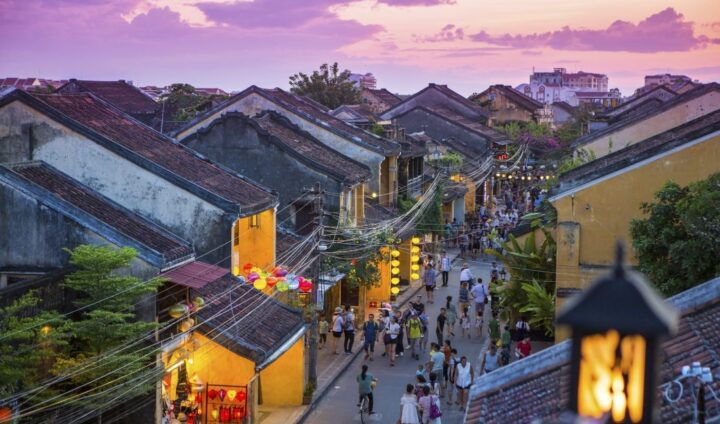
Hoi An Tips: What to see and do in Hoi An
Tea rooms, teak houses, thousands of colorful lanterns: you can hardly escape the flair of Hoi An on the old Silk Road. A stroll through what is probably the most charming city in Vietnam. Hoi An tips…
When night falls in Hoi An, even hardened globetrotters melt away. The world turns into a colorful dream in which the colors of the rainbow blur into a play of lights. Countless lanterns flicker on the facades of houses, on balconies, bridges and the small boats that slowly glide down the Thu Bon River.
The water shimmers in pastel tones, lovers are chatting, small wine bars invite you to an aperitif. The city on the central Vietnamese coast looks like a cliché come true – almost too good to be true. No wonder Hoi An is hailed as the Southeast Asian country’s most charming spot.
“When it gets dark, it seems as if the place has donned a new, shimmering and imaginative dress,” says a German tourist. She almost has the feeling that time stands still in Hoi An at night, she enthuses.
Even during the day, the town enchants with a labyrinth of narrow streets in which pretty wooden houses, temples, tea rooms, boutiques and markets await. Rickshaw drivers invite you to take round trips, while lantern sellers offer their silky, luminous range of products.
Evidence of illustrious history
Founded by the Cham people in the 4th century, the city later served as a port and trading center for the Champa Kingdom. It then lost its importance until traders from China and Japan settled there in the 16th century.
Hoi An became the country’s most important trading port and one of the main transhipment points on the legendary Silk Road. Later, the Portuguese, Dutch and French, among others, established trading posts here. Even today, buildings from different eras bear witness to the illustrious history of the city.
Hoi An has been a UNESCO World Heritage Site since 1999 – because of the original wooden constructions and the street plan, which together present a cityscape from the 17th and 18th centuries that is unique in the region, as the UN cultural authority explains.
A shrine over the river
One of the most important testimonies from the time as a trading metropolis is the “Japanese Bridge”, the city’s landmark. Chua Cau is also called the wooden covered bridge that once connected the Chinese and Japanese quarters. In its present form, the structure has existed over a tributary of the Thu Bon River since 1763.
Inside, incense sticks smell in a small shrine, framed by yellow lanterns. The little temple is dedicated to a Taoist deity who watches over the weather. Sailors, merchants and locals came – and still come – here to ward off storms and natural disasters.
Strolling through the overpass supported by thick wooden beams is like jumping into another time. Only a few fans that circulate the sizzling hot air are a reminder that the days of the old Silk Road are long gone.
Historic house with an Instagram factor
Architectural gems and idyllic temple complexes line the streets. There is the “Ba Mu” temple complex with its striking entrance gate in the classic Vietnamese style, which is reflected in a green glittering pond from which lotus flowers stretch out towards the sunlight.
One of the most visited buildings in Hoi An is the house of Tan Ky. Here you can get a glimpse of how wealthy traders lived in Vietnam in the 18th century. The four small rooms are packed with antiques. A guide tells visitors that the architecture is a unique blend of Chinese, Japanese and Vietnamese influences.
If you leave the house through the back exit, you will immediately find yourself in front of a popular Instagram motif. Several tourists pose happily in front of the yellow-painted facade.
A peaceful place of mourning
Another highlight is the assembly hall of the Chinese from Fujian: Hoi Quan Phuoc Kien. Built more than 300 years ago, Thien Hau is worshiped here, goddess of the sea and protector of seafarers. The light-flooded hall is filled with statues and animal figures from China. The air is pervaded by aromatic fumes.
Because huge red incense spirals hang from the ceiling, to which notes are attached – also from European tourists. Wishes and messages are written on it, which are to be sent to the deceased via the smoke.
It’s a beautiful, peaceful place to mourn. A French family writes: “Maybe you can live a little longer here with this burning incense stick. With all our love, your children and your wife.” It will take weeks, possibly weeks, for the enormous coils to burn out.
Dusk falls and Hoi An is in top form. Lanterns defy the gathering darkness. People flock to the “Bridge of Lights” (Cau An Hoi) over the Thu Bon River. The name says it all – from the Bridge of Lights, the view of both banks lit up by the lanterns is very impressive.
A performance along the epochs
If you want to learn more about the history of the place, buy a ticket for the show “Hoi An Memories”. The spectacle at a purpose-built theme park is so lavish that some compare it to the opening ceremony of the Olympic Games.
Vietnam’s largest outdoor theater is located on an island in the Thu Bon River. Hundreds of actors and dancers perform here every evening and tell the story of the place from its beginnings through the Silk Road heydays to the present day – including a large merchant ship and around 100 women in Vietnam’s national dress Ao Dai, who walk along fairytale-like illuminated paths in the water .
The typical house facades are reproduced in the background. Silk lanterns shine at every gate. Its unique play of lights is the constant of Hoi An amidst all historical turbulence and changing cultural influences.
Categories: General
